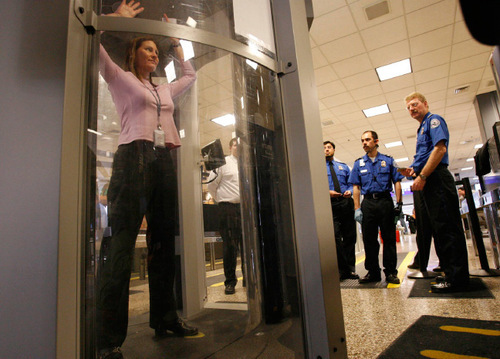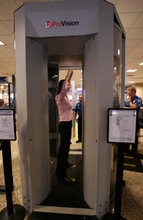This is an archived article that was published on sltrib.com in 2010, and information in the article may be outdated. It is provided only for personal research purposes and may not be reprinted.
The Transportation Security Administration is installing a second full-body scanner at Salt Lake City International Airport this week, as part of a broader plan to roll out hundreds more of the controversial machines by year's end.
The scanner will be placed at the security checkpoint alongside a metal detector already in place in the international terminal. It could be running by Friday, TSA spokesman Dwayne Baird said.
TSA chose the international terminal because its security area could be revamped quickly to make room for the scanner, which will use radio waves to produce images of passengers through their clothing.
Last year, TSA installed the airport's first scanner in Terminal 2, which is used by Delta Air Lines and its regional partners. Use of the scanner was voluntary; less than 1 percent of passengers opted out, Baird said Tuesday.
More scanners are coming to the airport, but Baird said he didn't know when.
"We do have a deployment plan, but that hasn't been completed and finalized," he said.
TSA plans to have 450 scanners installed in airports nationwide this year, and 500 more by the end of 2011.
The high-tech devices allow TSA screeners to see through clothes and find hidden objects, such as plastic explosives, that metal detectors can't spot.
"They've proven to be successful, in that we've been able to detect more than 130 items that were either prohibited, illegal or dangerous at points nationwide since January of this year," Baird said.
Metal detectors would not have been able to find those items, he said.
The quarreling over scanners hasn't abated since TSA began deploying the so-called "advanced imaging technology" devices in 2007, even though the agency has set up ways to guard passenger privacy.
"There's no ability to store [images]. They can't be transmitted, printed or saved in any way," Baird said.
Charles Leocha, director of the Consumer Travel Alliance, isn't persuaded. The group, which promotes consumer travel rights, has asked Congress to suspend the screening program.
"The same problems are still there, in terms of basically making us walk through security naked," Leocha said.
"And to add insult to injury, the TSA has now decided they are going to do a full, palm-forward pat-down for passengers going through security," he said. Such a pat-down is reserved for folks who decline the full-body scanner and instead choose the metal detector.
"They are treating you like a common criminal. I believe it's the same pat-down they give prisoners in prison," Leocha said.
"Pat-downs are one important tool to help TSA detect hidden and dangerous items such as explosives," TSA said in a statement. "Passengers should continue to expect an unpredictable mix of security layers that include explosives trace detection, advanced imaging technology, canine teams, among others."
TSA uses two kinds of scanners. Millimeter-wave machines, like those at the Salt Lake City airport, surround passengers with electromagnetic waves to produce 3-D images that blur the face but clearly show the body's shape and contour. The images are displayed on monitors.
Backscatter imagers emit low-level X-rays that render a passenger's clothes invisible. The result is a flat picture that looks like a chalk drawing that shows genitalia and other body parts.
Third District Rep. Jason Chaffetz, R-Utah, co-authored a bill last year to block wide use of whole-body scans.
Scanners at the airport
Terminal 2 • Delta Air Lines and its regional partners use a full-body scanner that was installed last year.
International terminal • New scanner will be installed this week.





